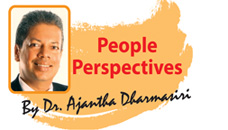Hiring as match-making
 In an increasingly competitive world, people have become a cutting
edge factor. Is it just any person or the right people? Hiring the right
person for the right job is important to achieve the right results. I
would compare hiring to match-making. As much as two people get together
through match-making, recruiting the right people needs committed
attention. There are triple matches needed to be fulfilled to ensure
that the right hiring takes place. Let's see what they are with emphasis
on the Sri Lankan context. In an increasingly competitive world, people have become a cutting
edge factor. Is it just any person or the right people? Hiring the right
person for the right job is important to achieve the right results. I
would compare hiring to match-making. As much as two people get together
through match-making, recruiting the right people needs committed
attention. There are triple matches needed to be fulfilled to ensure
that the right hiring takes place. Let's see what they are with emphasis
on the Sri Lankan context.
David Oglivy, the advertising tycoon, had this to say with respect to
hiring: "If each of us hires people who are smaller than we are, we
shall become a company of dwarfs, but if each of us hires people who are
bigger than us, we will become a company of giants". To hire people with
potential, the hiring process has to be professionally designed and
executed.
 Hiring is one of the critical people functions of any organization.
In the traditional jargon, it is known as recruitment and selection.
Recruitment deals with getting enough applicants as a potential pool.
Selection deals with picking the best from the pool. That's where
matchmaking becomes significant. Hiring is one of the critical people functions of any organization.
In the traditional jargon, it is known as recruitment and selection.
Recruitment deals with getting enough applicants as a potential pool.
Selection deals with picking the best from the pool. That's where
matchmaking becomes significant.
Triple matches
There are triple matches you need to ensure in selecting the right
candidate for a job. They are T-T match, P-P match and I-I match.
T-T match. This is the first match a recruiter would look into. It
stands for matching tasks with talent. This essentially refers to a
technical dimension. Any key task needs specific talent. Take a sales
job for example. Tasks associated with meeting customers needs the
talent of caring communication. Today, the word talent is often used as
a bundled word for knowledge, attitude and skills. Prof. Dave Ulrich in
his recent work, referred to it as a combination of competence,
commitment and contribution. Whichever way you describe it, there is a
dire need for it.
There is an acute gap between needed talent and raw talent. The
market is abundant with raw talent, especially school-leavers. Are they
geared to a demanding job in a target-driven environment? Sadly, the
answer is no.
We teach complex subject matter but not how to gain confidence.
Job-orientation in academic courses has been recognized as important
only of late. That is the way to overcome the talent drought.
In the global scenario, we have often heard about 'winning the war
for talent'. It is a term coined by Steven Hankin of McKinsey way back
in 1997. Ed Michaels, Helen Handfield-Jones and Beth Axelrod popularized
it in their book highlighting an increasingly competitive landscape for
recruiting and retaining talented employees.
They stressed the need to have a set of superior Human Resource
processes, but a mindset that emphasizes the importance of talent to the
success of organizations.
P-P match. This is the match between person and position. It goes
beyond the level of talent. The primary focus here is psychological.
Overall fit with regards to the personality of the person and the key
expectation of the position he or she is supposed to hold.
Let's be clear about personality. The term originates from the Latin
word, persona, which means a mask. In ancient Latin theatre, a mask was
used to represent a character. In other words, it is what you show to
the world, by way of words and deeds.
Different personalities suit different positions. An outgoing,
talkative and friendly person would be more suited for a sales position,
whereas a quiet, thinking and analytical person would be better in
handling a laboratory position.
Key challenges for HR practitioners is to determine what type of a
personality is associated with a candidate and also what type of a
personality is ideally needed by a specific position. Well-developed
tools associated with psychometric testing can be very handy in this
context.
I-I match. The final match is between the individual and the
institution. Essentially it checks the fit between the prospective
candidate and the 'surroundings'. It can be the culture, climate or the
overall style of management.
Thus we can see the socio-cultural dimension in focus. I have seen
many times high performers in one set up ending as lousy performers in
another set up. This is sad but significant, in ensuring the long-term
well-being of people.
The first key element here is culture. Organizational or corporate
culture is the pattern of values, norms, beliefs, attitudes and
assumptions that may not have been articulated but shape the ways in
which people behave and things get done. Climate is something people
see, hear and feel. That is why we see a difference when we enter a
hospital, police station or a restaurant.
What is important here is the need for prospective candidates to
appreciate institutional culture. What one can do in a multi-national
corporation might not be possible in a family-owned business. The same
gulf exists between the private and public sectors.
I have seen people who work in non-governmental charity organizations
having a high sense of humanity with committed service in mind. It might
be the same with a brilliant management trainee joining a rapidly
expanding global network.
The obvious sign is the need to ensure an individual-institutional
match.
Sri Lankan organizations can enhance their hiring professionalism by
ensuring the triple matches. It will pave the way not only for higher
organizational performance but also for better employee satisfaction.
Dr. Ajantha S. Dharmasiri is the Director of the Postgraduate
Institute of Management. He also serves as an Adjunct Professor in the
Division of Management and Entrepreneurship, Price College of Business,
University of Oklahoma, USA. |

